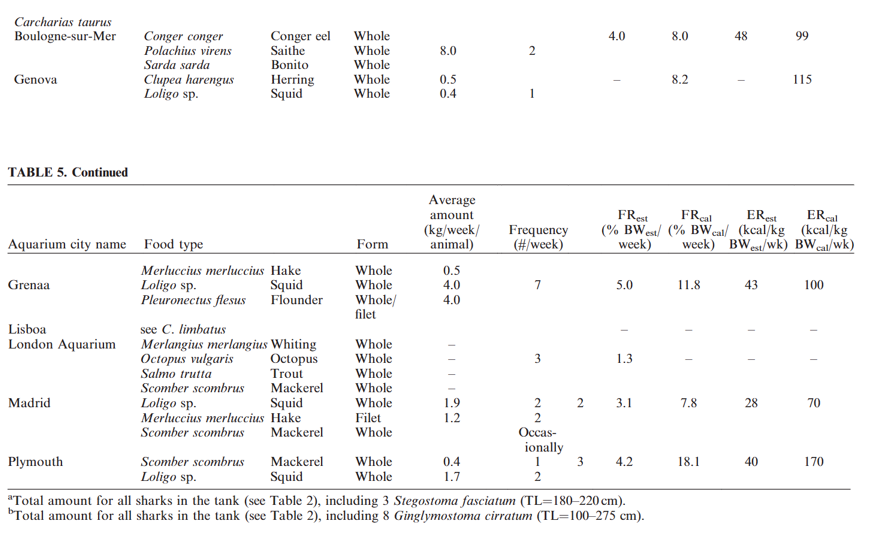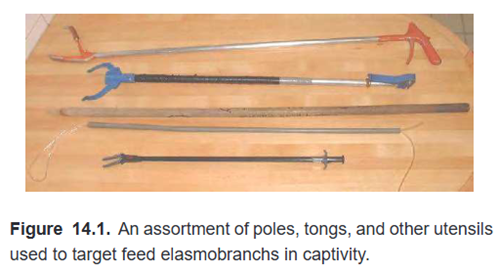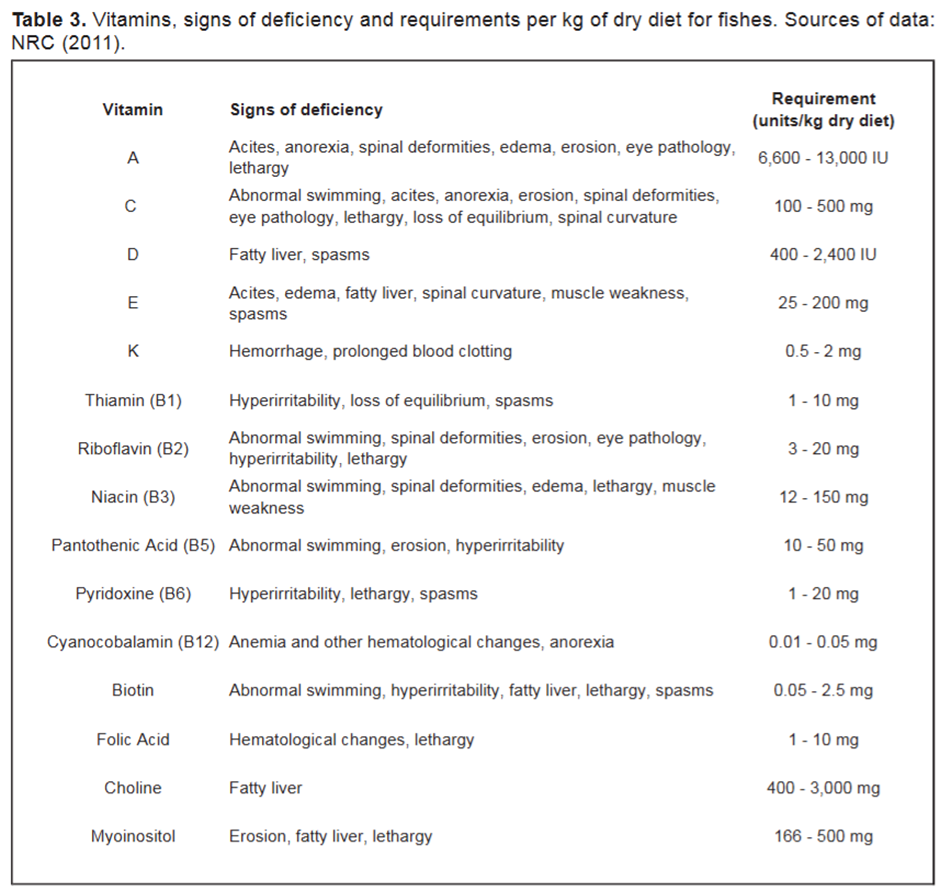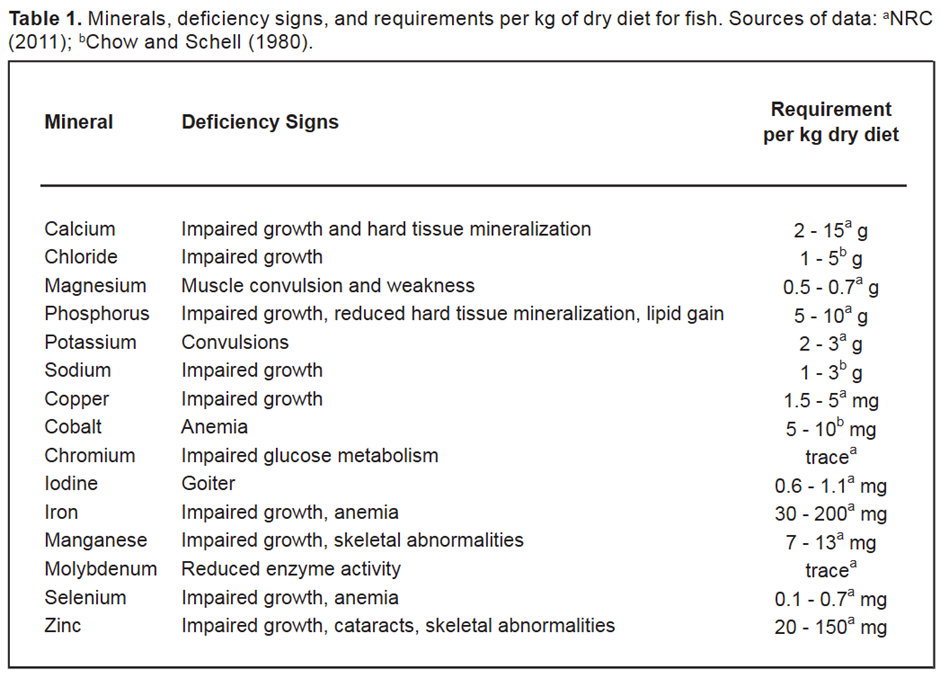Diet & Nutrition
Dietary Needs & Feeding Strategy
Sand tiger sharks (STS) are opportunistic piscivores that primarily feed on bony fishes but have been known to consume crustaceans, invertebrates, and on occasion, small sharks and rays depending on the region (Lucifora et al., 2009). Their dietary flexibility can greatly vary their nutritional profile in the wild making it challenging to replicate accurately (Hoopes et al., 2022). Due to gaps in knowledge about macronutrient thresholds in the wild, dietary management should aim to prevent deficiencies rather than mirror wild diets precisely. Therefore, diets are often simplified; primarily comprising of squid (logilo sp) with another commercially available teleost available to the region along with supplements (Figure 1). However, the exact amount fed to individuals can vary greatly with diets and schedules vary significantly between institutions in Europe with some being fed ad-libitum and anywhere between 3%-18% of their BW weekly. This inconsistency has left individuals vulnerable to preventable non-infectious diseases noted here (Preventative Health).
Our recommended diet and feeding schedule follows advice from the AZA nutritional group (Maia et al, 2023), which can be used to calculate weekly energy demand (Table 1).
Formulated Diet Breakdown
| Body Weight (kg) | Daily Energy Requirement (kcal) | Weekly Energy Requirement (kcal) |
|---|---|---|
| 10 | 60.57 | 423.99 |
| 20 | 105.46 | 738.22 |
| 30 | 145.87 | 1021.09 |
| 40 | 183.62 | 1285.34 |
| 50 | 219.51 | 1536.57 |
| 75 | 303.61 | 2125.27 |
| 100 | 382.18 | 2675.26 |
| 125 | 456.88 | 3198.16 |
| 150 | 528.62 | 3700.34 |
| 200 | 665.42 | 4657.94 |
Age Considerations
Fasting can be used strategically to simulate wild feeding patterns or control calorie intake. This also can adapt to the institutions regional limitations readily. In the wild, juveniles have a higher metabolism therefore would consume smaller and more frequent crustaceans to larger fish. Therefore they may require daily feeding equating to 3%-5% of their BW which can be reduced upon reaching maturity(230- 280 cm TL)(AZA, 2012)). Alternatively, seasonal fasting may benefit gravid females as observed in captive behaviors that mirror natural reproductive cycles (Bansemer & Bennett, 2011; Townsend & Gilchrist, 2017).(Figure 6).
Feeding Schedule & Methods
Most institutions employ feeding stations and/or target feeding using poles or tongs are used(Figure 2). Unlike other species, STS readily come to the surface to feed and are highly food motivated making them receptive to classical conditioning, seen in a 2017 survery whereby 32 of 39 are station trained (AZA, 2012). Individual identification using skin patterns allows accurate tracking behaviour and can prevent overfeeding. These sharks have the ability to consume food to satiation making ad-libitum feeding possible however overnutriton or unsustainable rapid growth, or the increase in weight without tail length, can lead increased prevalence of health issues. Additional feeding may be required if predation on other species is observed. Interactions have been documented well due to the species long history in captivity(Enclosure Design).
Practical Considerations
Food must always be frozen to -20°C, then thawed slowly over the course of 36 hours at 4-7°C without the assistance of running water. This process is to prevent the transmission of residual parasites whilst also preventing the loss of water-soluble vitamins (C & B1) from blanching (Hoopes et al,. 2017). Whilst fillets have been used, whole fish should be preferred in order to maximise vitamin intake and therefore reduce the need for further supplementation. Unlike herbivorous specie, carnivorous fish require far more keeper invention in supplying essential vitamins, therefore supplements vitamin E, vitamin C, Iodine, Calcium, and Thiamine (B1) are the standard. These can be administered as paste, injected or dusted at the institutions discretion.
Bony fish options like sardines (Sardina pilchardus), hake (Merluccius merluccius ) , and mackerel (salmo trutta) are widely available, commonly used in collections and can be bought in bulk and locally making them cost effective,. Alternatives can include; Octopus (O.vulgaris), Flounder (pleuronectus flesus), Whiting (merlangius merlangius) and Troutc(Merluccius merluccius) (Janse, 2004). Availability may differ by country although telost substitutes have shown no difference in growth or preference although frustration may occur if acclimation onto new food is not carried out, but rotating food choice slowly every two weeks can maintain novelty and balances nutritional profiles as long as baseline nutritional profile are met. A majority of non-infectious diseases are the result of deficiencies in nutrition (FIGURE 4, 5).
| Ingredient | Common Name | Amount |
|---|---|---|
| Loligo sp. | Squid | 3.9 kg |
| Scomber scombrus | Mackerel | 0.5 kg |
Vitamin & Mineral Additions:
- Calcium: 5–10g
- Thiamine (B1): 45mg/kg
- Vitamin C: 100mg/kg
- Iodine: 1mg/kg
- Vitamin E: 2–6g
Proximate Composition of Supplemented Diet
| Nutrient | Value |
|---|---|
| Crude Protein (%) | 78.34 |
| Crude Fat (%) | 8.24 |
| Calcium (%) | 1.6 |
| Phosphorus (%) | 0.9 |
| Copper (mg/kg) | 152.376 |
| Iodine (mg/kg) | 1 |
| Iron (mg/kg) | 39.927 |
| Vitamin A (IU/g) | 39.5 |
| Vitamin B1 (mg/kg) | 46 |
| Vitamin C (mg/kg) | 123.55 |
| Vitamin E (mg/kg) | 37.99 |





